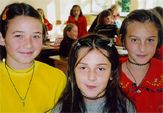 |
| Kosov@ Serbian girls during AWB art workshops. |
| |
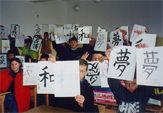 |
| Kosov@ Serbian kids display Japanese calligraphy
they received from their pen pals or learnt during the
workshop. |
| |
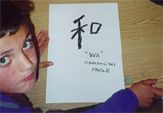 |
| Kosov@ Albanian kids (south of Kosovska
Mitrovitsa) learning "WA"(harmony, peace). |
| |
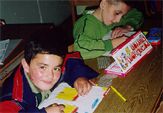 |
| Kosov@ Gorantsy kids, refugees from the
south of Kosov@, now in the north part of Kosovska Mitrovitsa. |
| |
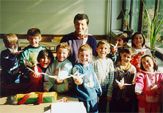 |
| Serbian kids (north of Kosovska Mitrovitsa)
after an ORIGAMI workshop. |
| |
|
 |
The war in Kosov@ caused approximately 800,000
refugees in neighboring Albania and Macedonia. About 200,000 more
are still displaced inside ex-Yugoslavia (now Serbia and Montenegro) and thousands are
feared dead. The NATO air strikes caused more than 1000
civilian deaths and killed an unknown number of Yugoslav
military men.
Despite the presence of 16,000 NATO troops and UN peacekeepers
(KFOR), revengeful attacks by returning Albanians caused
nearly 200 deaths and 150.000 Serb, Roma (Gypsy), Bosniak
and Gorantsy refugees left Kosov@. About 1,500 persons of Serb or Roma
(Gypsy) ethnicity and about 3.000 of Albanians are still missing.
Ethnic unrest also spread to the Preshevo
valley and the border with Macedonia!
Approximately two million children in ex-Yugoslavia have
experienced the horror of war. They not only need medical
care, food, water, etc. They also need psychological
relief. Although their school process has returned
to normalcy, they lack basic school materials.
ARTISTS WITHOUT BORDERS organized
a donation of art supplies and school materials
by Japanese children.
Japanese children donated sketchbooks, colored pencils
or crayons to an unknown Albanian, Serbian, Gypsy (Roma)
or Goranets friend in Kosov@. On the first page Japanese children attached
a picture of themselves, made a colorful drawing and written a little message
of support and solidarity to their unknown friend.
ARTISTS WITHOUT BORDERS took during the autumn
of 1999 (and will continue bringing) those school materials
to children in Kosov@ and will organize painting contests
by children.
By donating school supplies (sketchbooks, crayons and
colored pencils), Japanese children permitted Kosov@
kids to express themselves freely and render their innocent
anti-war impressions. By expressing themselves, children
have the opportunity to attain catharsis
(spiritual purification) that is probably the most important
function of art. Catharsis through
art is an essential part of psychological (mental and
emotional) healing.
Kosov@ Albanian, Serbian, Montenegrin, Roma (Gypsy),
Turk, Bosniak, Gorantsy kids... children of all the ethnicities
living in Kosov@ replied with their drawings and messages
to their Japanese pen pals.
ARTISTS WITHOUT BORDERS brought those letters
back to Japan thus, creating links of friendship between
the two countries.
The artistic expression of Japanese children and children
who have been victims of war is being collected to promote
peace worldwide through post-cards, albums and exhibitions.
ARTISTS WITHOUT BORDERS is a
neutral organization. In this page the spelling Kosov@
(or Kosovo/a) was used in order to guarantee total neutrality.
Kosovo is the Serbian name, while Kosova is the Albanian
name for the Autonomous region of Kosovo and Metohia
in the South of Serbia, ex-Yugoslavia. Mostly inhabited
by ethnic Albanians seeking independence, Kosov@ remains
a place of high ethnic tension.
ARTISTS WITHOUT BORDERS has taken
a message of peace and reconciliation to the areas of
ethnic intolerance and war. Forgiveness and coexistence
are, after all, the only long-term solution to those conflicts.
|
| |
|











